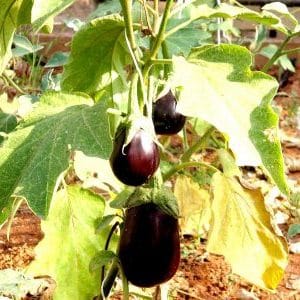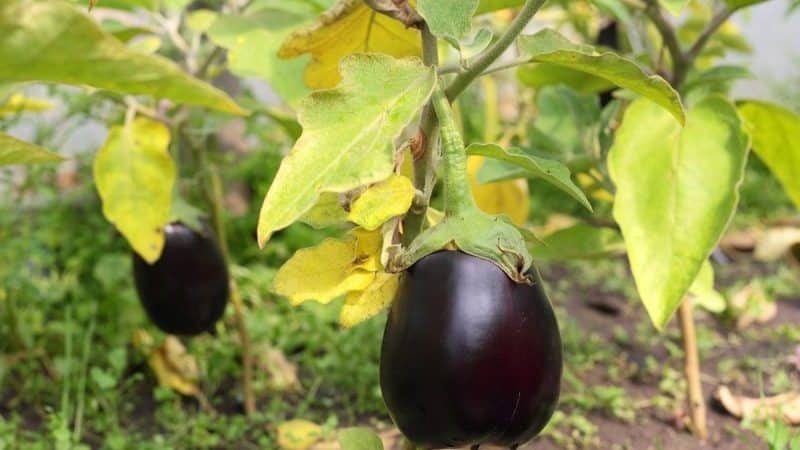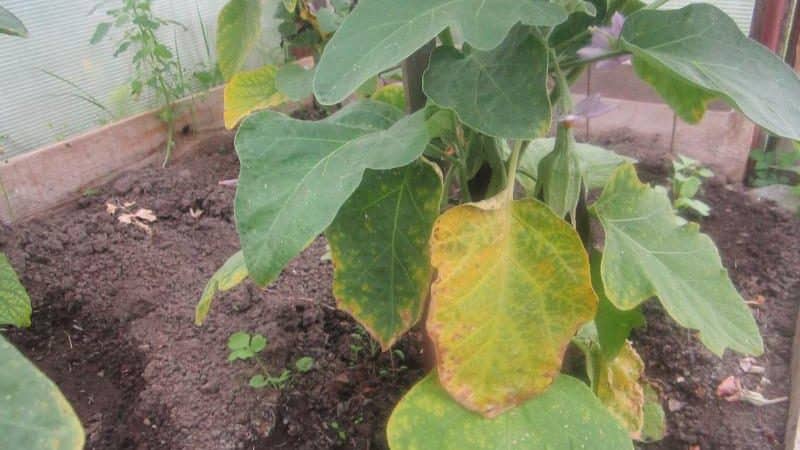What to do if eggplant leaves turn yellow in a greenhouse
Eggplants are consistently popular among Russian summer residents. They are grown in open areas and in greenhouse conditions, but it is not always possible to obtain a high-quality harvest. One of the problems is yellowing of the leaves.
In the article you will find the answer to the question, Why are the eggplant leaves in the greenhouse yellow? or pale, and learn how to deal with this phenomenon.
What causes eggplants to turn yellow in a greenhouse?
Eggplants cannot be called a whimsical and capricious crop.. But like any other plants, they need to create favorable conditions for growth and fruiting. Violations of agricultural practices or errors in care lead to yellowing of greenhouse vegetables leaves. Gradually they crumble, the eggplants are left with bare stems, flowering and growth stop completely, and fruits do not set. In this case, all that remains is to remove the crop from the summer cottage.
Unsuitable soil
Eggplants need light, loose and nutritious soil with a neutral acidity level. It is better to choose sandy or loamy soil, ideally fertile black soil. To do priming more nutritious and rich, clay soil is added to sandy soil, and sawdust or sand is added to peat soil. Adding chalk or lime will reduce the acidity.
It is recommended to add as fertilizers:
- humus;
- ash;
- a mixture of saltpeter or urea, potassium sulfate or superphosphate;
- any other mineral complexes.
It is better to grow vegetable seedlings in specially prepared formulations, which are sold in stores. They are well balanced and contain a full range of essential nutrients.
Reaction to transplantation into a greenhouse
Every plant experiences stress after transplantation. Eggplants can also weaken during the adaptation period. There is no need to worry about one or two yellowed leaves, but if they begin to fall off en masse, it is recommended to maintain the viability of the crop.
If there are no other causes of yellowing, the blue ones will quickly take root and become covered with green foliage again. During this period, it is important to provide sufficient light and regular watering.
Root damage
If the root system is damaged during transplantation, the process of supply of nutrients and water to all parts of the plant is disrupted. Therefore, young seedlings are handled with extreme caution. When replanting plants, it is advisable not to remove them from the soil, but to transfer them along with the earthen lump.
Experienced gardeners recommend using peat pots for these purposes. They are more suitable for rooting and developing seedlings than traditional wooden boxes.
Delicate roots are often damaged when loosening the soil in a greenhouse. This should be avoided by carefully weeding the beds without disturbing either the stems or the underground part of the eggplants.
Incorrect watering mode

In warm and dry weather, the crop should be watered at least 2 times a week until active flowering begins. When flowers appear and fruits begin to set, water 2-3 times every 10 days.
Important! Pour water carefully, only onto the ground, without wetting the stem and leaves. The amount of liquid should be enough to completely saturate the soil layer where the roots are located.
Temperature changes
Eggplants are sensitive and heat-loving plants.. They instantly respond to temperature fluctuations: frosts at night and extreme heat during the day. Varieties bred for the southern regions or brought from the south do not take root well in the northern regions. If yellow leaves appear after transportation and transplantation, it means that the crop cannot adapt to the new climate.
Due to temperature changes, the foliage becomes pale and lifeless. But if you provide the plant proper care, over time it will recover and begin to bear fruit.
Nutrient deficiency or excess
Due to a lack of nutrients, the vegetable quickly weakens and dies. Lack of nitrogen has a particularly negative effect. The plant spends all its energy to ensure the transport of substances to the young developing leaves, while the lower ones remain without nutrition.
Important! Weeds should not be allowed to appear in the greenhouse, otherwise they will further reduce the content of useful components in the soil.
You can determine which substance is missing by its appearance:
- nitrogen deficiency - the bush turns pale, the stems become thinner;
- potassium - the foliage curls up into a boat, shrinks and turns yellow;
- phosphorus - the leaves become at an acute angle in relation to the stem and grow almost vertically;
- zinc - brown or gray spots form.
An abundance of fertilizers is also unacceptable. From an excess of potassium-calcium nitrate, vegetables quickly die even at the stage of flowering and fruit set.
Close fit
It is important for each specimen in the greenhouse to be given enough space for proper growth and development. When the planting is dense, the lower parts of the plant do not receive enough sunlight, so they die.
On each seed package, the manufacturer provides useful information about planting dates and recommends a placement pattern that is most suitable for a particular variety.
Diseases and pests
The most common disease of eggplant is leaf mosaic. It manifests itself as yellow spots of irregular shape on the foliage, which eventually merge and completely affect the plate. The disease spreads quickly, so when the first signs are detected, it is better to dig up the bush and burn it.
Yellowed leaves are a sign of fungal infection:
- late blight - the appearance of brown or brown spots with a yellowish or green border;
- Alternaria - small dots cover the entire leaf plate;
- anthracnose - large oval-shaped spots.
Pests do not neglect the plant either. Eggplants are often attacked by whiteflies, aphids, fungus gnats and spider mites. Only fungicides or homemade compounds will help get rid of them.
Natural process
As the eggplant matures and ages, some parts of the eggplant die off. This is a natural process that allows the plant to get rid of unnecessary leaves that interfere with the normal growth of young ones. In this case, nothing needs to be done.
What to do and how to treat
A wilting plant needs urgent help, otherwise the entire bush will die. It is very important to correctly identify the cause and eliminate it in a timely manner.
Eliminating care errors
If the plants are too crowded in the greenhouse, they are thinned out so that there is enough space between the beds for bright lighting of all planted eggplants. If there is a lack of natural light, ultraviolet lamps are used.
One of the mistakes is a lack of moisture or its excess.The soil should not dry out completely, but it should not be flooded either, so that water does not accumulate at the roots. Vegetables require regular loosening to provide oxygen to the root system.
In the greenhouse, all weeds are eliminated, and adult plants are pruned (excess shoots are removed), which has a beneficial effect on fruiting.

Fertilizer application
An effective way to compensate for nutritional deficiencies is to add complex mineral compositions. Nitrogen-containing preparations can be prepared at home:
- dilute 1 tbsp. l. urea in 1 bucket of warm water;
- dissolve 1 liter of mullein in 10 liters of water;
- 0.5 liters of chicken manure per 6 liters of water.
The solution is poured at the rate of 0.5 liters under each bush. Eggplants are sprayed with the same product to activate fruiting. You should not get carried away with this method; you can repeat the procedure only after 15 days.
Reference. To eliminate potassium deficiency, add herbal ash. Its absorption directly depends on air temperature. If the thermometer rises above +35°C, the plant will not absorb the microelement. Therefore, it is important to regularly ventilate the greenhouse, open the windows, and mulch the soil.
Experienced gardeners carry out foliar feeding with a milk solution or yeast infusion.
Treatment by means
If eggplants are infected with fungus or other diseases, use special preparations. They are sold as a ready-made solution and sprayed onto all parts of the bushes. Once the plant gains strength, it will continue to develop and form young leaves.
Attention! Complete chemical treatment before flowering begins. Especially when fruits are ripening, it is dangerous to use insecticides and fungicides.
Chemical methods
To eliminate a number of diseases (gray rot, bacterial spot, late blight, blackleg), the following compositions are used:
- copper sulfate;
- Bordeaux mixture;
- "Kuproksat".
Preventive measures for plant treatment begin 24-27 days after the first seedlings emerge, and then continue for 21 days after planting in the greenhouse.
Vertimek, Inta-Vir, Decis Profi, Confidor Extra, Actellik, etc. are used as protective agents against pests. These are potent compounds, so usually 1-2 treatments with an interval of 2 are enough weeks.
Folk remedies
They are much safer for plants and humans, especially when used repeatedly. The most popular among summer residents are the following:
- against spider mites and aphids - decoctions of chamomile, wormwood, yarrow for spraying;
- from whiteflies - pollination with a solution of ash, infusion of nut leaves;
- for aphid larvae - an infusion of dandelion parts minced through a meat grinder.
Compliance with eggplant growing conditions will reduce the use of processing compounds.
Prevention measures

In preparation for the growing season, it is recommended to treat the soil in the greenhouse on which the eggplants grew.
An effective preventive measure against yellowing of foliage is treating the soil with Lamador or Maxim fungicides. These products destroy viruses and bacteria, and also increase the immunity of vegetable crops.
"Trichodermin" is recommended to be applied to the wells as an antifungal agent. Preventing diseases is always easier than subsequently dealing with problems and saving the harvest.
Preventive measures also include:
- selection of early-ripening, most disease-resistant varieties and hybrids with a short growing season;
- pre-sowing seed treatment (calibrate by size, separating large and small seeds, disinfect with a weak, light pink solution of potassium permanganate or hydrogen peroxide);
- treating the greenhouse with acaricides or insecticides to combat sucking insects that carry diseases;
- regular feeding of vegetables;
- periodic loosening of the soil to saturate it with oxygen;
- planning the correct proximity of planted crops and observing crop rotation rules;
- regularly checking all instances to detect problems in a timely manner.
Eggplants grow well in areas where cabbage and cucumbers, legumes and root vegetables, onions and corn, herbs and zucchini were previously planted. According to the rules of crop rotation, eggplants, like other nightshades, can be planted in one area with a break of three years.
Important! Pests and diseases that cause yellowing of leaves are combated by planting calendula, tansy, petunia, chamomile, and marigolds. They repel the Colorado potato beetle, ants, caterpillars, rodents, and also prevent the development of nematodes.
Fungus develops in greenhouses if the temperature exceeds +29°C. Fusarium spores quickly penetrate through the roots into all parts of the plant, and it dies. Regular ventilation, as well as moderate watering without stagnant water in the beds, will help prevent the problem.
To prevent the appearance of yellow leaves, it is enough to follow the rules of care and planting. Timely removal of weeds, regular watering with warm water, adequate lighting and timely application of fertilizers - all this will prevent possible problems and get a rich and high-quality harvest.
Conclusion
To save eggplants in a greenhouse, it is important to understand why their leaves turn yellow: due to inappropriate soil, temperature changes, nutrient imbalances, improper care, or pests. The sooner you identify the cause and take measures to eliminate it, the greater the chance that the plant will grow with renewed vigor and delight you with a rich harvest.